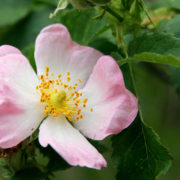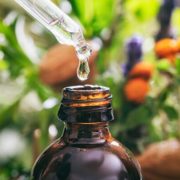“How much should I take?” I hear this question multiple times a day. I often answer with a standard response to follow the directions on the bottle, because I don’t have 30 minutes to explain the art of dosing to every customer, so it is my hope that this article will help to clarify the nuances a bit.
There are many different perspectives on dosing, and there is not one concrete answer (sorry type A people). In truth, the dosage that one should use very much depends on the individual’s constitution (i.e. kapha types tend to require larger doses than vata types), how the herbal remedy is prepared (infusion, tincture, flower essence), and what the desired effect is (are we going for subtle encouragement, a nutritional/tonic effect or a strong heroic action?).
Many tincture bottles will recommend something in the range of 20-60 drops 3-4 times a day, and this is a good standard for many people. It should be noted that this dosage is for an adult weighing 150 lbs. Children’s dosing will always be lower (divide child’s weight by 150; multiply the recommended adult dose by this fraction to get the child’s dosage level). And people weighing less than 150 pounds may find that they need less than the recommended dose, while larger people may need to take more. That being said, these recommendations are arbitrary. There are no scientific standards for dosing. Even the British Herbal Pharmacopeia offers no explanation on how the recommended dosages originated; it appears that they are largely based on theory and tradition.
I often recommend that one starts smaller than the recommended dose and build up if needed, because you can always increase the amount of tincture or the frequency with which you take it. My goal is to always help the client find the minimum effective dose, and this takes some experimentation. As a consumer of herbal medicine, you must be engaged with the medicine that you are taking, and pay attention to your body so that you can notice the gradual shifts that occur. It requires a different level of participation than popping a pill in your mouth and expecting relief to happen within 30 minutes.
That’s not to say that herbs cannot offer quick relief, but again, it depends on your end goal. When practiced allopathically, large doses of herbs can suppress symptoms. A more holistic approach, however, is to use small and frequent dosing to shift the tissue states of the interior ecosystem, and bring about slow but lasting changes to restore balance.
Here are some general guidelines to keep in mind when deciding where to start:
- Tonic herbs and herbs taken for their nutritional value can be safely used in larger amounts, and taken for longer periods of time than herbs being used to treat a specific symptom or override a specific bodily process (i.e. “regulating” herbs).
- Acute vs. Chronic: using herbs for chronic conditions generally calls for smaller doses taken over longer periods of time, while treating acute conditions requires higher doses for shorter periods of time.
- Methods of preparation play a role- tinctures are generally more concentrated than powders or teas. Decoctions are more concentrated than infusions. You’ll have to become somewhat familiar with the different methods of preparing herbs to know which preparation might be best for you. And sometimes preparation is a matter of preference. Some people simply cannot be bothered to make a tea, while some prefer the relaxation and ritual of a tea over the harshness of a tincture. I like to use teas for daily nourishment or when I’m feeling sick from a viral infection and I prefer tinctures as a convenient way to get other herbs in on a daily basis.
- Strength of the medicine plays a role- Within the category of tinctures, you’ll find that some are more concentrated than others. Store-bought tinctures will have a ratio of herb : menstrum (i.e. 1:2 or 1:5) on the label. For a 1:2 tincture, one ounce of herb was used for every 2 fluid ounces of liquid. This is a very strong tincture. Folk methods of preparation will usually be closer to a 1:10 ratio, meaning that 1 ounce of herbs was infused into 10 fl oz of liquid. Given the variability of strengths, it is good to experiment, starting low and titrating up until you find your sweet spot (more on this below…)
- Constitutions play a role- as I mentioned above, some people respond faster than others to herbal treatment than others. People with a lot of stagnation tend to need more material doses to get things moving in the body before they can detect the subtle effects of smaller/energetic doses.
- Specificity plays an even more important role- meaning, the better the match between plant and person, the less of the herb you will need. I’ll elaborate on this a little bit more below.
As herbal medicine and the collective consciousness evolve, the trend seems to be toward less is more. We are embracing subtlety and appreciating the low-impact methods of harvesting and preparing botanical remedies such as plant essences, which do not even require that one harvests the plant that they are using (one exception is the increased popularity of essential oils, which requires massive amounts of plant material to yield a tiny, highly concentrated drop). I have noticed an unofficial movement in the world of herbalism towards energetic ways of working with the plants. More and more practitioners and teachers seem to be offering classes and guidance on clinical use of flower essences, plant spirit medicine, and more of a spiritual understanding of a plant’s virtues (which often correlate with the physical actions of the plant…as above, so below)
Essences and homeopathic are energetic preparations that work differently than material preparations. They work on the vibrational body, on the subtle energy patterns of the body, mind and spirit. You can achieve a similar vibrational effect by using drop doses of tinctures. Drop dosing, energetic dosing, spirit dosing, and etheric dosing– all relatively new vocabulary to describe the same concept. When working with this type of dosing, it’s best to have a clear idea of the indications and nuances for each herb being used, and to apply the herbs to fit specific patterns in a person (as opposed to trying milk thistle because it sounds like an amazing herb and your liver could probably use some support).
So, the smaller the dose, the more it acts on the energetic pathways. The large the dose, the more it acts on the physiological mechanisms of the body, through the presence of phytochemicals present in the plant. The perspective behind the smaller dosing methods is one that recognizes a vital life force and innate intelligence in the body as well as the plant. It’s the interaction between the vital force that ultimately produces a unique effect. Conversely, the approach behind material dosing focuses more on the plant’s chemical constituents and how these interact with the physiological mechanisms of the body. These two approaches are not mutually exclusive and both offer valuable wisdom.
How do you know which one to use?
Ask yourself why you are using this particular herb. Are you reaching for your echinacea to ward off a cold? In that case, you would want to take material doses of echinacea, and very frequently, to achieve the surface immune activation that you seek. Did the herbalist from your local herb shop recommend rose petal as an ally for you because a) it supports your current state of grief and heartache and b) it seems to be a good match for you generally as it is balancing for your hyperactive immune system and your constricted liver qi? If an herb’s indications seem to fit you to a T, then you can use a smaller material dose (i.e. 3-10 drops of tincture instead of 30-60). In this case I would also encourage you to play with rose on all levels and get to know it intimately (try it as a tea and also infuse the petals into your bath water, plant a rose bush next to your house and get to know it through the seasons, and experiment with different ways of incorporating rose into your daily life).
Or, maybe it’s the herb’s spiritual properties that you are most interested in (i.e dandelion flower essence for people who work too hard and need help slowing down)? Maybe you want support in your quest to distance yourself from your mother’s overbearing influence, in which case drop doses of black walnut or an essence of black walnut may be best for you.
Another reason to opt for the energetic dosing is because it feels safer, as there are less contraindications reported. As I am writing this, pregnant with my second child, I know how confusing it can be for an expectant mother to get clear answers about which herbs are safe for her to use throughout pregnancy. Many, many herbs are contraindicated in material doses for pregnant women (many of which are perfectly safe in small-moderate doses). As an herbalist who feels comfortable knowing how many of these plants feel in my body, I have continued to use some of my favorites throughout my pregnancy without concern, but I often use less than I would normally use.
“As a rule, the dose should be the smallest quantity that will produce the desired result” – John M. Scudder
This is very good advice from an Eclectic physician. When in doubt, start small and work up to larger doses. Use energetic dosing (a few drops of tincture, homeopathic preparations and flower essences) to work on the subtle, emotional layers, and material doses (30-60 drops or more of tincture or a strong nourishing infusion/decoction) for conditions that seem more acute, physical, dense, and deep. And there is no reason that you can’t apply both, especially for a chronic condition. Try your formula in material doses for a few weeks, then switch to energetic doses for a week and notice how they each make you feel. When it comes to knowing what is best for your body, you are your own best guide.
by Ashley Davis, 2019
Ashley is a clinical herbalist, teacher, gardener, and co-owner of Tonic Herb Shop in Shepherdstown, WV (www.tonicherbshop.com)
 In partnership with Sacred Garden School of Herbalism, Tonic is the host of a new low-cost Wholistic Wellness Council.
In partnership with Sacred Garden School of Herbalism, Tonic is the host of a new low-cost Wholistic Wellness Council.
 It is not just this culture that celebrates this season by offering gratitude. Cultures around the world have felt the pull to show respect for abundance, for life, and also death as part of the great cycle.
It is not just this culture that celebrates this season by offering gratitude. Cultures around the world have felt the pull to show respect for abundance, for life, and also death as part of the great cycle.
 While we enjoy the mainstream hoopla and stream Hocus Pocus 2, I want to unpack some of the modern associations that we have about witches. Why do we fear them? Why do we think they can fly? Why do they use such creepy ingredients in their potions? And what’s up with the pointy hats?
While we enjoy the mainstream hoopla and stream Hocus Pocus 2, I want to unpack some of the modern associations that we have about witches. Why do we fear them? Why do we think they can fly? Why do they use such creepy ingredients in their potions? And what’s up with the pointy hats? So, what is the significance of the pentagram? It’s the signature of Venus. The planet Venus makes a 5-pointed star, or 5-petaled rose during her 8 year cycle around the sun. Much can also be said about the pentagram and sacred geometry. It follows the golden ratio and a star can be divided into fractals of stars/pentagrams. The angles of a pentagram are 108 degrees, which is a sacred number in Vedic and Buddhist philosophies. Read more
So, what is the significance of the pentagram? It’s the signature of Venus. The planet Venus makes a 5-pointed star, or 5-petaled rose during her 8 year cycle around the sun. Much can also be said about the pentagram and sacred geometry. It follows the golden ratio and a star can be divided into fractals of stars/pentagrams. The angles of a pentagram are 108 degrees, which is a sacred number in Vedic and Buddhist philosophies. Read more 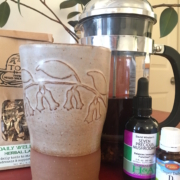
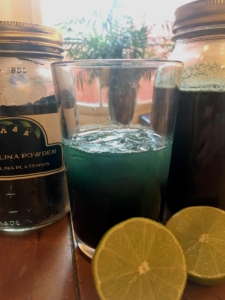 Then, in the afternoon, I have been enjoying a
Then, in the afternoon, I have been enjoying a 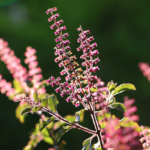 Tulsi (aka Holy Basil) is an Ayurvedic tonic herb with a calming & clarifying effect on the brain & nervous system. It is also an adaptogen, but it it has a lighter and more diffusive energetic than other adaptogens, making it acceptable for use in fevers and accute conditions. Tulsi is not recommended for women who are pregnant or nursing, but otherwise has no contraindications.
Tulsi (aka Holy Basil) is an Ayurvedic tonic herb with a calming & clarifying effect on the brain & nervous system. It is also an adaptogen, but it it has a lighter and more diffusive energetic than other adaptogens, making it acceptable for use in fevers and accute conditions. Tulsi is not recommended for women who are pregnant or nursing, but otherwise has no contraindications.